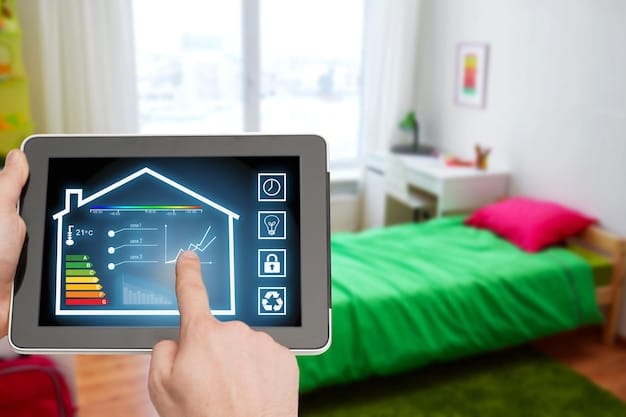Reduce Carbon Footprint: 7 Energy-Saving Habits for a Greener Life

Reducing your carbon footprint involves adopting energy-saving habits like using energy-efficient appliances, reducing water heating, and embracing renewable energy, ultimately contributing to a more sustainable lifestyle and a healthier planet.
Want to make a real difference for the environment? You can **reduce your carbon footprint: 7 energy-saving habits to adopt today** are not just good for the planet; they can save you money and improve your quality of life too.
Understanding Your Carbon Footprint
Before diving into energy-saving habits, it’s helpful to understand what a carbon footprint is. Simply put, it’s the total amount of greenhouse gases generated by our actions.
These gases trap heat in the atmosphere, contributing to global warming and climate change. Everything from the electricity we use to power our homes to the food we eat and the transportation we rely on has an impact.
Calculating Your Impact
Many online tools can help you estimate your carbon footprint. These calculators take into account factors like your energy consumption, transportation habits, diet, and spending habits to provide you with an estimate of your impact.
Understanding where your carbon footprint is highest can help you identify areas where you can make the most significant changes.
The Importance of Reducing Your Footprint
Reducing your carbon footprint is crucial for mitigating climate change and protecting the environment. By taking small steps to reduce our impact, we can collectively make a big difference.
- Preserving natural resources for future generations.
- Reducing air and water pollution.
- Protecting ecosystems and biodiversity.
- Promoting a healthier and more sustainable future.
Knowing your carbon footprint and understanding its wider implications is the first step towards creating a greener, more sustainable everyday life.

Habit 1: Switch to Energy-Efficient Appliances
One of the most impactful changes you can make is upgrading to energy-efficient appliances. These appliances are designed to use less energy, saving you money on your utility bills and reducing your environmental impact.
Look for appliances with the Energy Star label, which indicates that they meet strict energy efficiency guidelines set by the Environmental Protection Agency (EPA).
Identifying Energy Star Appliances
The Energy Star label is a reliable indicator of energy efficiency. These appliances have been tested and certified to meet certain performance standards, ensuring they use less energy than standard models.
When shopping for new appliances, prioritize Energy Star-certified models to maximize your energy savings.
Examples of Energy-Efficient Appliances
- Energy-efficient refrigerators and freezers.
- Energy-efficient washing machines and dryers.
- Energy-efficient dishwashers.
- Energy-efficient air conditioners and heaters.
Investing in energy-efficient appliances can lead to significant energy and cost savings over the lifespan of the appliance.
Habit 2: Reduce Water Heating
Water heating is a significant energy consumer in most households. Reducing the amount of hot water you use can have a considerable impact on your carbon footprint and energy bills.
There are several simple ways to reduce water heating, from taking shorter showers to using cold water for laundry and washing dishes.
Simple Tips for Reducing Hot Water Use
Making small changes to your daily habits can significantly reduce your hot water consumption. These tips are easy to implement and can lead to noticeable energy savings.
Consider these small adjustments to help reduce your hot water use.
Practical Steps to Conserve Water
- Take shorter showers.
- Fix leaky faucets.
- Wash clothes in cold water.
- Insulate your hot water heater.
Embracing these water-saving habits can help you reduce energy consumption and lower your utility bills.
Habit 3: Embrace Renewable Energy
Switching to renewable energy sources is one of the most effective ways to reduce your carbon footprint. Renewable energy sources, such as solar, wind, and geothermal, produce little to no greenhouse gas emissions.
By embracing renewable energy, you can significantly reduce your reliance on fossil fuels and help mitigate climate change.
Exploring Renewable Energy Options
There are several ways to embrace renewable energy, depending on your location, budget, and energy consumption needs. From installing solar panels on your roof to purchasing renewable energy credits, there are options to suit every situation.
Look into the different ways to harness renewable energy and choose the one that suits your needs best.
Implementing Renewable Energy Solutions
- Install solar panels on your roof.
- Purchase renewable energy certificates (RECs).
- Participate in a community solar program.
- Switch to a renewable energy provider.
Embracing renewable energy can significantly reduce your carbon footprint and support a cleaner, more sustainable energy system.

Habit 4: Optimize Your Home’s Insulation
Proper insulation is essential for maintaining a comfortable indoor temperature and reducing energy consumption. Insulating your home helps to keep it warm in the winter and cool in the summer, reducing the need for heating and cooling systems.
Optimizing your home’s insulation can significantly reduce your energy bills and lower your carbon footprint.
Checking Your Home’s Insulation
Start by assessing your home’s current insulation levels. Check attics, walls, and crawl spaces for adequate insulation. If you find areas with little or no insulation, it’s time to take action.
Identify the areas in your home that need additional insulation to improve energy efficiency.
Practical Insulation Tips
- Insulate attics and walls with fiberglass, cellulose, or spray foam.
- Seal air leaks around windows and doors with caulk or weatherstripping.
- Install insulation in crawl spaces and basements.
- Consider professional insulation services for optimal results.
By improving your home’s insulation, you can create a more energy-efficient and comfortable living environment.
Habit 5: Drive Less and Drive Smart
Transportation is a major contributor to greenhouse gas emissions. Reducing your reliance on cars and adopting more sustainable transportation options can significantly lower your carbon footprint.
Consider walking, biking, or using public transportation whenever possible. When driving is necessary, practice fuel-efficient driving habits.
Fuel-Efficient Driving Techniques
Even when driving is unavoidable, there are steps you can take to improve fuel efficiency and reduce emissions. These techniques can help you get the most out of every gallon of gasoline.
Adapt the way you drive to improve fuel economy.
Strategies for Sustainable Transportation
- Walk or bike for short trips.
- Use public transportation.
- Carpool with colleagues or friends.
- Maintain your vehicle properly.
By driving less and driving smart, you can reduce your transportation-related carbon emissions and promote a more sustainable transportation system.
Habit 6: Reduce Food Waste
Food waste is a significant environmental problem. When food is wasted, all the resources used to produce, transport, and store it are also wasted, contributing to greenhouse gas emissions and environmental degradation.
Reducing food waste is an easy and effective way to lower your carbon footprint and conserve resources.
Planning and Storing Food Wisely
One of the best ways to reduce food waste is to plan your meals in advance and store food properly. This helps you avoid buying more food than you need and ensures that food stays fresh for longer.
Make the most of the food you buy, without letting it go to waste.
Tips for Minimizing Food Waste
- Plan your meals in advance.
- Store food properly in airtight containers.
- Use leftovers creatively.
- Compost food scraps.
By reducing food waste, you can conserve resources, lower your carbon footprint, and save money on groceries.
Habit 7: Support Sustainable Products and Practices
Choosing sustainable products and supporting environmentally friendly practices helps to reduce your carbon footprint and promote a more sustainable economy.
Look for products made from recycled materials, certified sustainable, and produced using environmentally responsible methods.
Certifications and Labels to Look For
Several certifications and labels can help you identify sustainable products and practices. These labels indicate that the product or service meets certain environmental or social standards.
Look for products with labels indicating that they meet the requirements for environmentally sound practices.
Making Conscious Purchasing Decisions
- Buy products made from recycled materials.
- Choose products with minimal packaging.
- Support companies with strong environmental policies.
- Look for certifications like Fair Trade and Organic.
By supporting sustainable products and practices, you can encourage businesses to adopt more environmentally responsible practices and contribute to a more sustainable future.
| Key Action | Brief Description |
|---|---|
| 💡 Energy Efficiency | Use Energy Star appliances to reduce energy consumption. |
| 💧 Water Conservation | Reduce hot water use by taking shorter showers and fixing leaks. |
| ☀️ Renewable Energy | Opt for solar panels or renewable energy providers. |
| ♻️ Reduce Waste | Minimize food waste and support sustainable products. |
Frequently Asked Questions
A carbon footprint is the total amount of greenhouse gases generated by your actions. It includes emissions from energy use, transportation, food, and other activities contributing to climate change. Understanding your footprint is the first step to reducing it.
You can calculate your carbon footprint using online calculators that take into account your energy consumption, transportation habits, diet, and spending habits. These tools provide an estimate of your environmental impact, helping you identify areas for improvement.
Reducing your carbon footprint is crucial for mitigating climate change and protecting the environment. By making small changes in your daily habits, you can help preserve natural resources, reduce pollution, and protect ecosystems for future generations.
Simple ways to reduce energy consumption include switching to energy-efficient appliances, reducing water heating, using LED lighting, and unplugging electronics when not in use. These small changes can add up to significant energy savings over time.
To support sustainable products and practices, look for products made from recycled materials, certified sustainable, and produced using environmentally responsible methods. Support companies that prioritize sustainability and reduce their environmental impact.
Conclusion
By embracing these seven energy-saving habits, you can significantly **reduce your carbon footprint** and contribute to a more sustainable future. Start making these changes today and join the growing movement of individuals committed to protecting our planet for generations to come.





